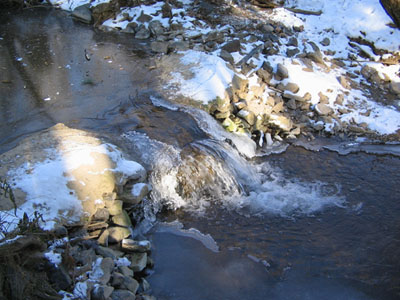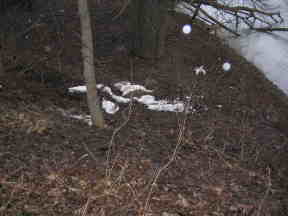 |
Ecological Dilemmas - Problem based Learning Nature provides a free lunch, but only if we control our appetites. ~William Ruckelshaus Business Week, 18 June 1990 |
 |
The choices we make impact ecosystems. Development is an obvious example of an impact. But there are many others.
Here are a few examples of how people impact wetlands: Runoff of lawn fertilizers & pesticides, winter salting of roads, sidewalks & parking lots, automatic dishwasher detergent, clothes washing detergent, grey water systems, discarded cigarette butts, medications in the potable water supply , soil erosion, mine drainage, careless dumping, weed and insect control programs, dioxins, waterway dredging, mercury toxins, flood control measures, glycol runoff, lead shot for hunting and lead sinkers for fishing, oil & chemical spills, West Nile Virus control programs, feeding wild animals - A Vicious Cycle, releasing alien species into the wild, and dams in waterways. General Ecology website
![]() Select one of these actions. (If there is another one that is of particular local interest, you may investigate it)
Select one of these actions. (If there is another one that is of particular local interest, you may investigate it)
Describe the action.
Explain the issue including its ecological impact. Show several sides of the argument.
Identify alternatives that achieve the goals of people, while minimizing or perhaps eliminating the negative impact.
Decide: Should the change be made?
How - by law, by regulation or by individual personal choice?
![]() Extend your efforts - Make a VE video about the issue.
Extend your efforts - Make a VE video about the issue.
(VE Rating - Very educational making a strong use of data and critical thinking skills.)
Excellent examples: Requiem for the Honeybee from Charles Greene CSPAN Student Cam project
Down to the Last DROP from Madison Richards CSPAN Student Cam project
Extend your thinking:
![]() Competition Conundrums - Two wetland birds are presenting challenges.
Competition Conundrums - Two wetland birds are presenting challenges.
Investigate one of the issues. What are some solutions? Double Crested Cormorants - OR - Canada Goose
![]() Wetlands: Habitat / Mammals / Birds / Aquatic insects / Plants & trees / Amphibians
Wetlands: Habitat / Mammals / Birds / Aquatic insects / Plants & trees / Amphibians
Wetland Vocabulary Exercise / Wetland food web / Map PA Waters / Make a schematic representation
Eagles Status Evaluation / Competition Conundrum / Lentic ecosystem or Lotic ecosystem?
Wetland or frog song activity / Wetland Poem Project / Water & Watershed Studies / Water Wars
Bats are our Buddies / Bats at the Beach Activity / Monitor Wetland
Map Wetlands in your Community / Pennsylvania HS Envirothon
Posted 9/2008 by Cynthia J. O'Hora Updated 3/2009
![]() Save a tree - use a digital answer format - Highlight the text. Copy it. Paste it in a word processing document. Save the document in your folder. Answer on the word processing document in an easily read, contrasting color or font. (No yellow, avoid fancy fonts like: Symbols,
Save a tree - use a digital answer format - Highlight the text. Copy it. Paste it in a word processing document. Save the document in your folder. Answer on the word processing document in an easily read, contrasting color or font. (No yellow, avoid fancy fonts like: Symbols, ![]() ,
, ![]() ). Save frequently as you work. Enter your name and the date in a document header. Submit the assignment via a class dropbox or an email attachment. Bad things happen. Save a copy of your document in your computer.
). Save frequently as you work. Enter your name and the date in a document header. Submit the assignment via a class dropbox or an email attachment. Bad things happen. Save a copy of your document in your computer.
Proof your responses. It is funny how speling errors and typeos sneak in to the bets work. ![]() Make your own printer paper answer sheet
Make your own printer paper answer sheet
Pennsylvania Science Anchors Pennsylvania Science & Technology Standards and Ecology & Environment Standards Science NetLinks Benchmark 5 - The Living Environment - How living things function and interact. A. Diversity of Life D. Interdependence of Life - " In all environments freshwater, marine, forest, desert, grassland, mountain, and others organisms with similar needs may compete with one another for resources, including food, space, water, air, and shelter. Aligned with Pennsylvania Academic Standards: Reading, Writing, Science & Technology, Ecology & Environment, Mathematics, Geography, Career. Aligned with National Academic Standards: Technology, Science, Geography. |